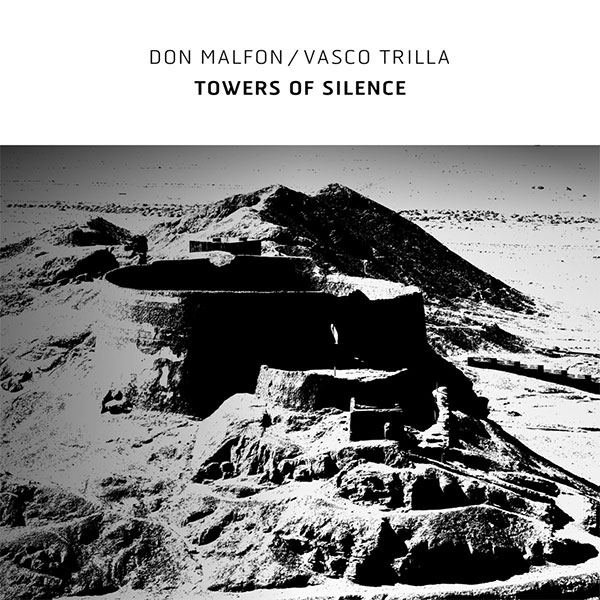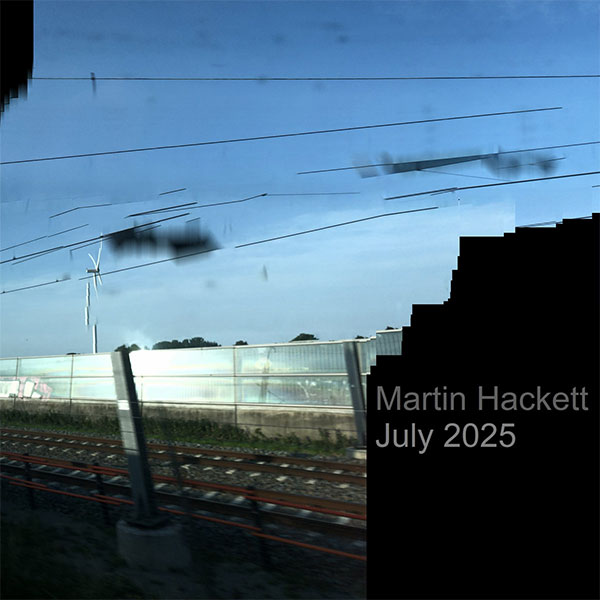


Little Tour Down to Texas and Back, Sandy Ewen (Scatter Archive)
Towers of Silence, Don Malfon / Vasco Trilla (Confront Recordings)
July 2025, Martin Hackett (Scatter Archive)
I love the notes Sandy Ewen provides to go with his album Little Tour Down to Texas and Back. I say ‘his album’, but he asks us to think of it less as an album and more, as I understand it, as an archive: ‘Improvised music is transient. It depends on context. It’s not meant to be precious. I don’t expect anyone to listen to this album all the way through. These [performances] weren’t performed with a release in mind so there is no overarching concept or goal. If you did try to listen from beginning to end, some elements would likely feel repetitive.’ He suggests we listen to only one track: ‘One single track is plenty of music for a single sitting. If, in a few days, or months, or years, you feel like revisiting it, you will be pleased to find something new.’ What he says, for me, sparks all sorts of thoughts about the contexts in which we make music. For example, how we make it in one era can create all sorts of assumptions which can all too easily get carried over for no good reason into another. These days, for example, our idea of an ‘album’ is still closely tied to how much music you can get on a vinyl LP. Music is mostly stored as computer files these days, but we still think and talk of albums, EPs and singles.
I took Sandy’s advice, and confined myself to listening to 04 June 2025 Carousel Lounge [Austin, Texas]. I’m pleased I did. I loved the attention to detail he pays to the sounds, something one’s ear might brush over if one listened to the whole album at once. I like his use of space, too, and the ambience of the performance space itself. These are live performances and, at least, in the Carousel Lounge, there are few extraneous sounds – on account of good miking but probably, too, because the performance is so absorbing – but what few there are find their way into a music which speaks the sort of language which can easily admit them.
I said I followed his advice. In fact, I have to confess I was having such a good time listening that I couldn’t resist a sneak preview of 04 June 2025 Rubber Gloves [Denton, Texas]: enough, at least, to discover it’s another great track. And yes, there is a venue in Denton, Texas called Rubber Gloves. A box containing the same caught the eye of one of the original owners when they were setting it up. They even hand-drew the venue’s logo of a woman in rubber gloves in front of a mic.
Towers of Silence is the latest release in a string of collaborations between saxophonist Don Malfon and percussionist Vasco Trilla which often – but not here – include other musicians (e.g., the guitarist Florian Stoffner). If you’re unfamiliar with Trilla’s work and want some idea of where he’s coming from, check out his 2018 album, The Torch in My Ear. As he put it himself, in an interview on the Free Jazz Blog, it was ‘very special for me, it’s probably where I thought I was finding my own voice as a solo percussionist’. (Listening to that album, what intrigues me is the creative tension between using instruments that, by their nature lend themselves to sharp attacks and time-limited decays, and a desire to create textures from sustained sounds). Malfon is another prolific sonic explorer who stretches the possibilities of his instrument to the limit, one who is more interested in juxtaposing sounds as an abstract artist might areas of colour than of making melodic shapes.
Listening to the music they make together, it’s sometimes hard to tell who is responsible for making which sound. The forms they create change shape slowly while, nonetheless, holding one’s attention. I was put in mind of Arnold Schoenberg’s idea of melodies of tone colours (klangfarbenmelodie). What Schoenberg contrived using an orchestra, Malfon and Trilla achieve with sax and percussion. Changes in texture – some subtle, some sudden – take the place of melodic and harmonic interest (the opening minutes of the second track are a good example of what I mean). Anyone interested in the work of improvisers who develop this line of musical thought can do worse than go back to ‘Farben’ (‘Colours’), the third of Schoenberg’s Five Orchestral Pieces. It was written in what was arguably the most interesting phase of Schoenberg’s compositional career, the period after he’d abandoned tonality and before he adopted twelve-note technique. His music at that time sometimes had a surprisingly improvisational feel to it for such a structurally-minded composer.
I wondered about the title, with it’s suggestion of Zoroastrian funeral practices, as this is music with so little silence in it. However, although it’s a contradiction in terms, if one wanted music to accompany silence, what Malfon and Trilla have created here would be just the thing. And you hear the detail in the sounds they use in close-up – the noise-elements, the attacks, the decays – in a way that one usually only can when the sounds in question are surrounded by silence. An intriguing and engaging album.
Martin Hackett is a member of Oxford Improvisers, the London Improvisers Orchestra, and the Muzzix collective in Lille, France. Although he plays various instruments he has developed a particular interest in ‘explorations of the possibilities’ – as the album-notes to July 2025 put it – of the KORG MS-10 synth. What I like particularly is how these explorations seem less about finding previously unheard, exotic sounds from the MS-10, and more about posing and answering the question, how do you make music from assembling the sounds a synth can make? By that, I don’t mean, how do you make a synth imitate more conventional instruments, but, given that synths open up possibilities in ways that no other instruments do, what new ways of arranging sounds in time do they suggest or make possible? It’s a question that’s been around since Moog and Buchla first developed voltage control and it’s still an exciting creative starting-point even now, sixty years later.
In the notes, Hackett shares with us the way he put it together, from ‘recordings of solo improvisations on Korg MS-10; listened to maybe once, or unheard; left for months, even years; eventually to become found materials for these new collaged pieces. Haphazard double-tracking reveals unsuspected relationships, sometimes asking for little or no modification [01], at others initiating a game of shifting and mixing, occasionally layering against field recordings.’ Anyone involved in making improvised or experimental music, be it public or their own spare room, knows how exciting that sounds: they, too, will probably have folders full of sound-files that never saw the light of day for one reason or another, but which warrant revisiting. One can sometimes find some of one’s best work in such places.
July 2025 is an album to lose yourself in; and it’s pretty obvious from the album and the notes that go with it that Hackett lost himself – in the best sense – in the making of it. The end result is music that is consistently spacious, playful and inventive.
.
Dominic Rivron
LINKS
Little Tour Down to Texas and Back: https://scatterarchive.bandcamp.com/album/little-tour-down-to-texas-and-back
Towers of Silence: https://confrontrecordings.bandcamp.com/album/towers-of-silence
July 2025: https://scatterarchive.bandcamp.com/album/july-2025
.
